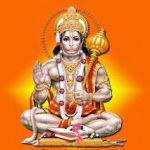Hanuman expanded the notion of the divine, perhaps more than any other being in Hindu mythology. He appeared as an agent governed by dharma like any human, yet while in an animal form he was divine. The myths of his birth from the elements of the gods, usually of Siva and Vayu (the wind god), proved his divinity. There were four different myths of his divine birth, ranging from the union of Siva and Vishnu to one about his mother, Anjana, eating a divine pudding that made her pregnant.
Hanuman’s name has traditionally been associated with the legend of (Sri Rama. Nevertheless, he has gained an independent status as a god in recent folk myths that have spread from northern to southern India. His status is evidenced by the popularity of the forty rhymes of Tulsidas (the great medieval poet), Hanuman Calisa, glorifying Hanuman as a deity, by his presence in popular films and poster art, and by the reverence shown to ordinary monkeys in modern India.
Myths about Hanuman told of his mighty power and his ability to perform superhuman tasks. Hanuman lifted up the whole mountain of Kailasa and brought it to Rama in order for him to find a special medicinal herb. Hanuman built the bridge across the ocean (setubandhana) to reach Lanka, slew the demoness of Mount Mainaka, and led his army of monkeys in the battle against Ravana.
Hanuman was portrayed in the myths as, and is still believed to be, a great yogi as well as an unusually talented musician. He was described as possessing the ashtha siddhis (the eight superhuman powers), such as being able to be light as a feather or impossible to move, to become invisible, to fly, and to reduce or enlarge his form. He was one of the rare beings who were truly immortal; he would never see death. Apart from all this, Hanuman was an erudite grammarian and poet. But what distinguished him from other Hindu gods was the way he acquired divine status—simply by his deep-rooted devotion to Sri Rama, who was an incarnation of Vishnu. He was, and is, the best example to Hindus of an ideal devotee and the most adorable and worshipped among the popular devotees in the Hindu pantheon. (Other examples are Dhruva, Prahalada, and Arjuna.)
An early reference mentioned Hanuman as an incarnation of the eleventh Rudra (a deva). It is quite possible that Hanuman might have been a deity of a local tribe, later adopted as a Hindu divinity.
The origin of this god can be traced back to the myth of the churning of the Milky Ocean as told in the Siva Purana, which stated that he was the son of Siva and the feminine form of Vishnu as Mohini. The semen of Siva was deposited in the womb of Anjana by the seven rishis (saptarishis). (A recent variation of the
Hanuman, the paradigm of loyal friend in his service to Rama, takes his divine form in order to bring a mountain with healing herbs. (TRIP)Hanuman myth associates the union of Siva and Mohini with the origin of Swami Ayyappa, a very popular deity in South India, merging past and present, theriomorphic deity and sage.)
Other variations of the story of the origin of Hanuman stated that he was the son of Vayu, the wind god, or the son of Kesari, the monkey chieftain. One account said that both Siva and Vayu assumed the form of Kesari and had intercourse with Anjana. As the son of Vayu Hanuman would be connected with the myths about Bhima, who in the Mahabharata is also a son of Vayu.
Hanuman was one of the few gods who has been given episodes in every period of Hindu mythology. His life stretched between two incarnations of Vishnu in this kalpa and involved associations with them both: with Sri Rama in treta yuga and with Sri Krishna in dvapara yuga, the age that followed. His devotees put these different embedded myths together to prove that Hanuman had a presence in all ages and thus had perfect immortality, a boon Hanuman was given by Sri Rama. He was known as one of the ciranjivis, the seven beings who would never experience death.
Iconographically, Hanuman is easily recognizable as a monkey who is either the loyal servant of Rama or the great warrior of the Ramayana. As a servant his two hands are held together in a mood of devotion (anjalihasta). As a warrior he holds a thunderbolt (vajra) in one hand, and his feet seem to tear up the ground beneath him.

